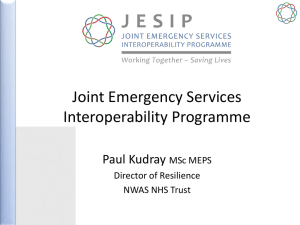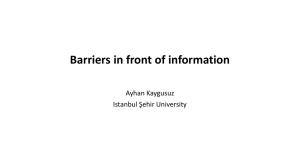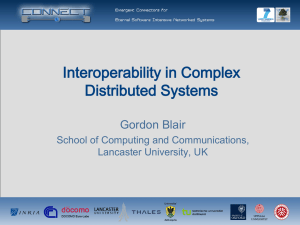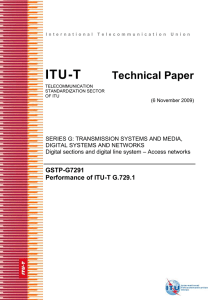Presentation - Technology Access Program
advertisement
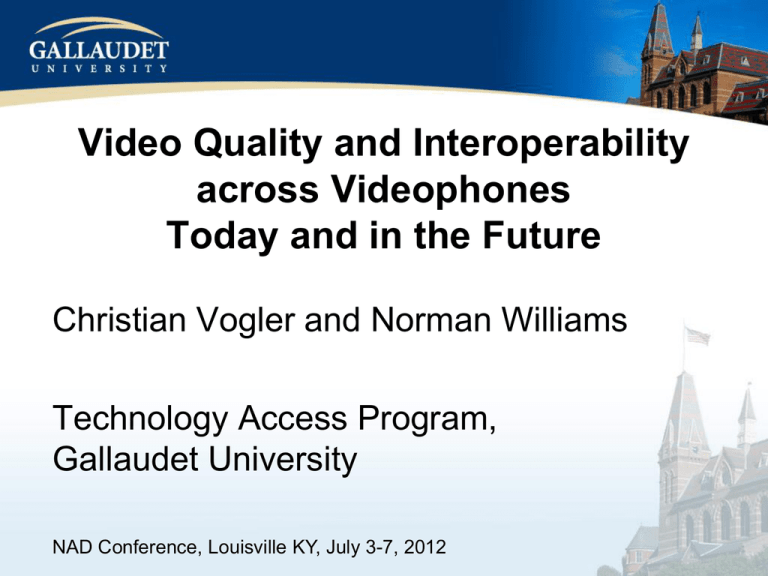
Video Quality and Interoperability across Videophones Today and in the Future Christian Vogler and Norman Williams Technology Access Program, Gallaudet University NAD Conference, Louisville KY, July 3-7, 2012 Overview • Who we are • The state of video calling today – Interoperability of videophones – Video quality • A look into the future – Technical standards and mainstream video calling – Better access to 9-1-1 Who we are • The Technology Access Program is a deaf-led research center at Gallaudet University • Research areas: – Telecommunications access – Videoconferencing access – 9-1-1 access – Hearing aid compatibility of phones – And other technology access issues Video calling today • What devices do you use for video calls? – Stand-alone videophone (e.g. VP-200, NTouch, Z-20, Z-340, Ojo, …)? – Your laptop or desktop computer? – Your mobile phone, pager, or tablet? Video calling today • What software do you use for video calls? – VRS app on your computer or mobile – Skype – ooVoo – Tango – Fring – FaceTime – Other? Video calling needs? • What devices would you like to use for video calls? – Stand-alone videophone? – Your laptop or desktop computer? – Your mobile phone, pager, or tablet? – Something else? Video calling needs? • What software would you like to use for video calls? – VRS app on your computer or mobile – Skype – ooVoo – Tango – Fring – FaceTime – Other? Video calling today It is worth remembering what the purpose of VRS and videophones is: Functional equivalence Can deaf and hard of hearing people use telecommunication services in the same unrestricted manner and at the same costs as hearing people? Functional Equivalence • Do we have it today? • Do you feel that we have equal access compared to the mainstream? Interoperability • Interoperability is a big barrier for us in the video calling world. – Interoperability: devices from different vendors and providers work with each other. • See what hearing callers can do: Voice interoperability Hearing callers can call each other with landline phones, mobile phones, Internet software, and leave messages via answering machines/voicemail. It just works. Video interoperability • Video interoperability isn’t as good • Many VRS apps and phones still can’t call each other • We ran tests to find out - Interoperability testing • Tested devices, software and apps from 5 major VRS providers: Sorenson, ZVRS, Purple, SnapVRS, and Convo • Tested only devices and software that are available to new customers Testing environment Testing method • Test live call from and to each device • Test leaving message on answering machine – Press “reject call” on answering phone to force answering machine on – One limitation: Some phones may behave differently if you just let the call ring – but this would have taken too long • 21 devices on each side, 882 calls total; took 2 weeks to complete Interoperability Results • Full results are in the spreadsheet on our web site: http://tap.gallaudet.edu/Conferences/NAD 2012/ • Some highlights: Interoperability Summary • Stand-alone VPs and computer software work better than mobile devices • Live calls work better than leaving messages Interoperability: Sorenson • Sorenson: – The stand-alone nTouch VP is compatible with many non-Sorenson products – nTouch PC and the mobile clients do not work with non-Sorenson products – Stand-alone nTouch VP can leave messages on most non-Sorenson products, but not vice versa – If the answering machine does not work, you may get a busy signal – it does not always mean that the person is using the phone Interoperability: ZVRS • ZVRS: – Generally works well with most other products for live calls – Can take incoming messages from most products – Problems with leaving messages on Purple answering machines; bug has been reported and may already have been corrected Interoperability: Purple • Purple: – Works well with most other products for live calls – Some problems with taking messages on answering machine – calls ring, but never connect to the answering machine. • Possibly due to a problem with sharing an account across multiple devices in our test setup – Purple and Convo products have problems talking to each other – Purple iOS client has problems if the Purple user rejects a call – the call does not go to the answering machine. Bug has been reported. Interoperability: SnapVRS • SnapVRS: – Tested only the Ojo stand-alone videophone – Generally works with other vendors’ products – Can take incoming messages from most products, some problems with taking messages from Purple products Interoperability: Convo • Convo: – Can leave messages on most other products’ answering machine – Cannot take incoming messages – no answering machine – Convo and Purple products have problems talking to each other Types of problems • Videophone does not ring – … you have no idea that someone called • Black/green screen – … the caller can’t see you or vice versa • Call gets disconnected – … you can’t finish your conversation • Answering machine does not work – … people can’t leave messages for you About mobiles … – Interoperability is worse than with standalone VPs and computer software – Data bandwidth and data caps (2 GB is just 2-4 hours of calling time) – With some iPhone and iPad VRS apps, the receiving side does not get the best video compression codec (H.264) • this means that they use twice as much data as other devices to get similar video quality – It takes months before new Android devices are supported – if at all – Some apps drain your batteries very quickly Interop: Consequences • All this means: – We still need more than one videophone or software application to keep in touch with all of our friends and family – It is dangerous to rely on the answering machine, especially if you try to run a business via your videophone – We still don’t have good ways to make mobile calls Video quality • Video quality is a confusing topic. • Lots of misinformation, and even the FCC and VRS companies do not always get it right What affects quality? WiFi signal VP network settings Internet connection Camera Mobile network Example video - 1 Example video - 1 • Possible Explanations: – Bad camera – Network speed is slow – Or a combination of both • How to solve: – Faster Internet plan – Get a good USB camera Example video - 2 Example video - 2 • Possible Explanations: – – – – VP network settings are too high WiFi interference Network congestion Too many mobile users in the area • How to solve: – – – – – Use lower VP network settings Faster Internet plan Switch your WiFi router to a different channel Use wired Ethernet Switch from 3G/4G mobile to WiFi Example video - 3 Example video - 3 • Possible Explanations: – Mobile network fluctuates – Network congestion • How to solve: – Lower the VP network settings – Switch from mobile network to WiFi or Ethernet – Faster Internet plan Example video - 4 Example video - 4 • Possible Explanations: – Some mobile devices don’t send the highestquality video (H.263 instead of H.264) • How to solve: – Wait for a faster mobile device – Ask your VRS provider why the mobile app does not send H.264 – Use a different device (e.g. a laptop instead of a tablet or phone) What is what? • Example video 1: Skype, 256 kBit/s network bandwidth • Example video 2: Two laptop VRS apps from different vendors, 256 kBit/s network bandwidth, one VP incorrectly set to 384 kBit/s • Example video 3: VRS app on iPad over Verizon 4G LTE to laptop, 256 kBit/s • Example video 4: VRS app on iPad over Verizon 4G LTE to laptop, 512 kBit/s More examples Which videos have acceptable quality? Raise your hand. What is what? 1. 2. 3. 4. 5. 6. 7. 8. nTouch VP to nTouch PC, 192 kBit/s nTouch VP to nTouch PC, 256 kBit/s nTouch VP to nTouch PC, 512 kBit/s Z4 to Z4, 256 kBit/s Z4 to Z4, 512 kBit/s Z4 to P3, 256 kBit/s Z4 to P3, 512 kBit/s Sorenson nTouch iPad to nTouch PC, Verizon 4G LTE 512 kBit/s 9. Skype unlimited bandwidth The biggest mistake • The biggest mistake people make is to use the wrong network setting in their VP: – Too high? You can forget about the conversation! – Too low? The video is less clear, but you can still talk. – The setting must be lower than the bandwidth: if you have a 256 kBit/s upload speed, you should choose 192 kBit/s in the VP. • Why do people have to mess with this setting anyway? It’s too complicated! – This should be automatic (like with Skype) – Complain to your VRS provider and the FCC The 256 kBit/s myth • Some VRS companies and the FCC have said that 256 kBit/s minimum network speed may be enough – Not really: this would require a 192 kBit/s setting in the VP (see previous slide) – 192 kBit/s gives poor video quality • Ask for a plan with 384 kBit/s or more upload and download speed • If you don’t need it, turn off audio Future of VRS • New technical standards – Interoperability – Mainstream calling and equipment – Total conversation (video, real-time text, audio) • Next-generation 9-1-1 Technical Standards • You may have noticed: Video quality between VPs from the same vendor is much better than across vendors – For the same vendor they use the better quality H.264 codec, while across vendors they use lower-quality H.263 Across vendors Same vendor Technical Standards • The FCC’s proposal for VRS reform: – Would make higher-quality video part of the standards – Would improve interoperability across VPs – Would improve interoperability with mainstream video calling equipment and software Mainstream calling • Imagine: If you could use any video calling equipment with VRS? – You could call friends, family, colleagues – deaf or hearing – all with the same equipment • This is important, because: – – – – – Less confusion about what works and what doesn’t Hearing people can’t get VRS equipment Companies like to use standard equipment VRS apps on mobiles are months late Better access to 9-1-1 Total Conversation • Video, audio, and (real-time) text in any combination – You decide how to communicate • Advantages of interoperable text channel: – Type information that is hard to fingerspell – Better access for deaf-blind: interpreter can type back – Better access for people who find it hard to sign but can understand ASL fine Total Conversation Next-gen 9-1-1 • Total conversation is at the heart of nextgeneration 9-1-1 services • Next-generation 9-1-1 also will allow direct video between you, the emergency responder, and a sign language interpreter Next-gen 9-1-1 • Demo of 3-way future 9-1-1 call Acknowledgments • The contents of this presentation were developed with funding from the National Institute on Disability and Rehabilitation Research, U.S. Department of Education, grant number H133E090001 (RERC on Telecommunications Access). However, those contents do not necessarily represent the policy of the Department of Education, and you should not assume endorsement by the Federal Government. • We are grateful to Verizon Wireless for lending us LTE equipment for testing. • Paula Tucker was an invaluable help with assembling the presentation. Questions • Questions? Comments? • Supplemental material: http://tap.gallaudet.edu/Conferences/NAD 2012/

